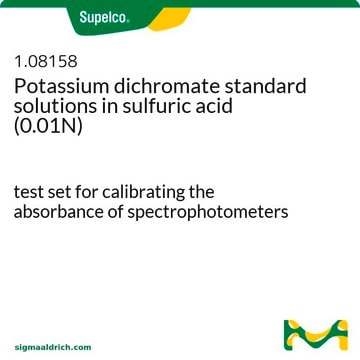If this product has an expiration or retest date, it will be shown on the Certificate of Analysis (COA, CofA). If there is no retest or expiration date listed on the product's COA, we do not have suitable stability data to determine a shelf life. For these products, the only date on the COA will be the release date; a retest, expiration, or use-by-date will not be displayed.
For all products, we recommend handling per defined conditions as printed in our product literature and website product descriptions. We recommend that products should be routinely inspected by customers to ensure they perform as expected.
For products without retest or expiration dates, our standard warranty of 1 year from the date of shipment is applicable.
For more information, please refer to the Product Dating Information document: https://www.sigmaaldrich.com/deepweb/assets/sigmaaldrich/marketing/global/documents/449/386/product-dating-information-mk.pdf
NIST136F
Potassium dichromate
NIST® SRM® 136f, oxidimetric standard
Synonym(s):
Potassium bichromate
About This Item
Recommended Products
grade
certified reference material
Quality Level
packaging
pkg of 60 g
manufacturer/tradename
NIST®
technique(s)
titration: suitable
mp
398 °C (lit.)
format
neat
SMILES string
[K+].[K+].[O-][Cr](=O)(=O)O[Cr]([O-])(=O)=O
InChI
1S/2Cr.2K.7O/q;;2*+1;;;;;;2*-1
InChI key
KMUONIBRACKNSN-UHFFFAOYSA-N
Looking for similar products? Visit Product Comparison Guide
Related Categories
General description
SRM 136F_CERT
SRM 136F_SDS
Application
Other Notes
Potassium Dichromate (K2Cr2O7)
See certificate for values and more details at nist.gov/SRM.
Legal Information
related product
Signal Word
Danger
Hazard Statements
Precautionary Statements
Hazard Classifications
Acute Tox. 2 Inhalation - Acute Tox. 3 Oral - Acute Tox. 4 Dermal - Aquatic Acute 1 - Aquatic Chronic 1 - Carc. 1B - Eye Dam. 1 - Muta. 1B - Ox. Sol. 2 - Repr. 1B - Resp. Sens. 1 - Skin Corr. 1B - Skin Sens. 1 - STOT RE 1 Inhalation - STOT SE 3
Target Organs
Cardio-vascular system, Respiratory system
Storage Class Code
5.1B - Oxidizing hazardous materials
WGK
WGK 3
Flash Point(F)
Not applicable
Flash Point(C)
Not applicable
Regulatory Listings
Regulatory Listings are mainly provided for chemical products. Only limited information can be provided here for non-chemical products. No entry means none of the components are listed. It is the user’s obligation to ensure the safe and legal use of the product.
EU REACH SVHC Candidate List
EU REACH Annex XVII (Restriction List)
EU REACH Annex XIV (Authorisation List)
Choose from one of the most recent versions:
Certificates of Analysis (COA)
It looks like we've run into a problem, but you can still download Certificates of Analysis from our Documents section.
If you need assistance, please contact Customer Support.
Already Own This Product?
Find documentation for the products that you have recently purchased in the Document Library.
Customers Also Viewed
-
How can I determine the shelf life / expiration / retest date of this product?
1 answer-
Helpful?
-
-
How is shipping temperature determined? And how is it related to the product storage temperature?
1 answer-
Products may be shipped at a different temperature than the recommended long-term storage temperature. If the product quality is sensitive to short-term exposure to conditions other than the recommended long-term storage, it will be shipped on wet or dry-ice. If the product quality is NOT affected by short-term exposure to conditions other than the recommended long-term storage, it will be shipped at ambient temperature. As shipping routes are configured for minimum transit times, shipping at ambient temperature helps control shipping costs for our customers. For more information, please refer to the Storage and Transport Conditions document: https://www.sigmaaldrich.com/deepweb/assets/sigmaaldrich/marketing/global/documents/316/622/storage-transport-conditions-mk.pdf
Helpful?
-
-
1. How can one locate a Certificate of Analysis (COA) for a NIST standard? 2. Are lot numbers assigned to NIST Standards?
1. How can one locate a Certificate of Analysis (COA) for a NIST standard?
2. Are lot numbers assigned to NIST Standards?1 answer-
1) You can find certificates and other product information on NIST’s website: https://shop.nist.gov/
Remove "NIST" prefix from our product number when searching on the NIST website (e.g. “136F” instead of “NIST136F”)
2) No, NIST does not have lot numbers, and instead the product number is changed.
NIST lots are denoted in their product numbers. Take NIST136F for example. The current lot is “F”, whereas NIST136E came before it. When NIST releases a new lot for Product 136, we will create a new product number, NIST136G, and so on.
Helpful?
-
-
What does the "3110" lot number signify in the system?
1 answer-
The "3110" lot number is used as a placeholder in the system when an actual lot number is not available.
In this particular instance, the way NIST numbers their lots does not align well with the lot numbering convention in SAP. NIST incorporates the lot identification within their product numbers. For example, for the product NIST136F, the lot is identified as "F", succeeding the previous lot "E". As new lots are released by NIST, a new product number is assigned, such as NIST136G for the subsequent lot, and the pattern continues accordingly.Helpful?
-
Active Filters
Our team of scientists has experience in all areas of research including Life Science, Material Science, Chemical Synthesis, Chromatography, Analytical and many others.
Contact Technical Service












